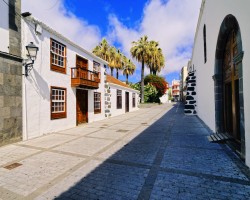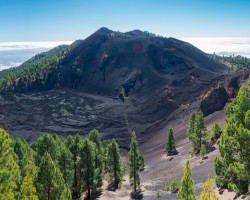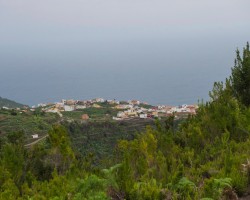Best time to go to La Palma for a perfect weather and where to go?
When is the best time to go to La Palma?
When is the best time to go to La Palma? Here's some information to help you in your decision:
- The weather is good on the island of La Palma throughout the year
- The weather is good all year in Los Llanos de Aridane
- On average, the warmest months in Los Llanos de Aridane are June, July, August, September, October and November
- The cities with the best climate are Los Llanos de Aridane, Los Canarios, Los Sauces, Tijarafe, El Paso, Fuencaliente de la Palma, Puerto Naos, Santa Cruz de La Palma, Santo Domingo (Garafía) and Tazacorte, with good weather at least 11 months a year
- The best months for swimming in Los Canarios are June, July, August, September, October, November and December
Annual weather on the island of La Palma
For information about the climate and the weather city by city on the island of La Palma for a specific month, click on the corresponding line below:
| Month | Our opinion | View Details | |||
|---|---|---|---|---|---|
| January | 67°F | good weather | |||
| February | 67°F | good weather | |||
| March | 67°F | good weather | |||
| April | 67°F | good weather | |||
| May | 68°F | good weather | |||
| June | 72°F | perfect weather | |||
| July | 74°F | perfect weather | |||
| August | 76°F | perfect weather | |||
| September | 76°F | perfect weather | |||
| October | 74°F | perfect weather | |||
| November | 72°F | perfect weather | |||
| December | 70°F | perfect weather |
Best time to travel to La Palma by cities
Temperatures and rainfall on the island of La Palma
On these 3 graphs, we present the evolution of temperatures of La Palma and month-by-month rainfall for the cities of Los Llanos de Aridane, Los Canarios, Los Sauces, Tijarafe and El Paso, as well as the month-by-month sea temperature for coastal cities.
Peak visitor numbers and tourist seasons on the island of La Palma
Find out when La Palma has its high tourist season (the period when the influx of tourists is highest) and off-peak tourist season using our data and figures.
Tourist seasons on the island of La Palma
The months with low numbers of tourists are: January, March, April, May, June, August, September, October and November. The number of visitors to La Palma is high in: February, July and December.
- Very low season on the island of La Palma: April, May, June, September and October.
- Low season on the island of La Palma: January, March, August and November.
- High season on the island of La Palma: February and July.
- Peak season on the island of La Palma: December.
Figure: Visitor index for La Palma month by month
Where to go on the island of La Palma?
This table allows you to see the maximum temperature for each city and our opinion on the weather month by month (see colour legend below the table).
| Cities | jan. | feb. | mar. | apr. | may | jun. | jul. | aug. | sep. | oct. | nov. | dec. |
| Los Llanos de Aridane | 67°F | 67°F | 67°F | 67°F | 68°F | 72°F | 74°F | 76°F | 76°F | 74°F | 72°F | 70°F |
| Los Canarios | 67°F | 67°F | 67°F | 67°F | 68°F | 72°F | 74°F | 76°F | 76°F | 74°F | 72°F | 70°F |
| Los Sauces | 67°F | 67°F | 67°F | 67°F | 68°F | 72°F | 74°F | 76°F | 76°F | 74°F | 72°F | 70°F |
| Tijarafe | 67°F | 67°F | 67°F | 67°F | 68°F | 72°F | 74°F | 76°F | 76°F | 74°F | 72°F | 70°F |
| El Paso | 67°F | 67°F | 67°F | 67°F | 68°F | 72°F | 74°F | 76°F | 76°F | 74°F | 72°F | 70°F |
| Fuencaliente de la Palma | 67°F | 67°F | 67°F | 67°F | 68°F | 72°F | 74°F | 76°F | 76°F | 74°F | 72°F | 70°F |
| Puerto Naos | 67°F | 67°F | 67°F | 67°F | 68°F | 72°F | 74°F | 76°F | 76°F | 74°F | 72°F | 70°F |
| Santa Cruz de La Palma | 67°F | 67°F | 67°F | 67°F | 68°F | 72°F | 74°F | 76°F | 76°F | 74°F | 72°F | 70°F |
| Santo Domingo (Garafía) | 67°F | 67°F | 67°F | 67°F | 68°F | 72°F | 74°F | 76°F | 76°F | 74°F | 72°F | 70°F |
| Tazacorte | 67°F | 67°F | 67°F | 67°F | 68°F | 72°F | 74°F | 76°F | 76°F | 74°F | 72°F | 70°F |
| Brena Alta | 67°F | 67°F | 67°F | 67°F | 68°F | 72°F | 74°F | 76°F | 76°F | 74°F | 72°F | 70°F |
| Brena Baja | 67°F | 67°F | 67°F | 67°F | 68°F | 72°F | 74°F | 76°F | 76°F | 74°F | 72°F | 70°F |
| Puntallana | 67°F | 67°F | 67°F | 67°F | 68°F | 72°F | 74°F | 76°F | 76°F | 74°F | 72°F | 70°F |
Legend:
perfect weather
good weather
About La Palma
What can I do on the island of La Palma?
Beaches / swimming
Nature and countryside
Culture and heritage
Sports
Family travel
Crafts / shopping
Gastronomy
Nightlife
Is this weather information for La Palma reliable?
Climate data for La Palma has been gathered every day since January 2009. The analysis of these meteorological data for La Palma allows us to determine the average for each month in Los Llanos de Aridane, Los Canarios, Los Sauces, Tijarafe, El Paso, Fuencaliente de la Palma, Puerto Naos, Santa Cruz de La Palma, and 5 other cities.
So yes: this data is reliable except in cases of temporary climate disruption in the region.











